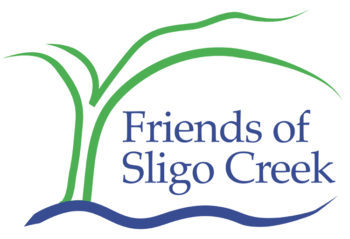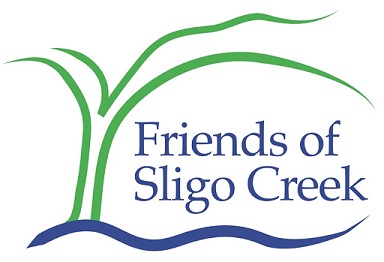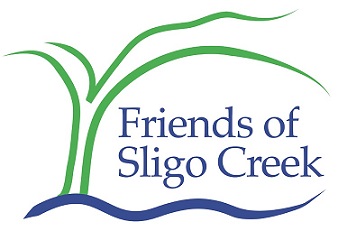Bird Nest Habitat and Invasive Plants
A Balancing Act for Sligo
A number of birds that breed in Sligo build their nests close to the ground, hidden away in dense shrubs and vines, both natives and invasives. These birds include fourteen of the most tuneful songsters of a Sligo springtime: white-eyed vireo, carolina wren, veery, wood thrush, catbird, mockingbird, brown thrasher, cardinal, common yellowthroat, kentucky warbler, and three kinds of sparrow: eastern towhee, field sparrow, and song sparrow. All are native to Sligo.
Although the shape and materials of an old bird nest are not sufficient to identify the species that built it, we can narrow down the list to the above since ornithologists know which birds build nests at low levels. (If you want to look for old bird nests, the best time is in November and December, before the winds, ice, and heavy snow of winter breaks them apart.)
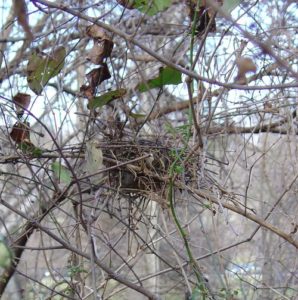
Nest with rose and greenbrier, Feb 2, 2005, above soccer field bridge along dirt path
Our native common greenbrier – a thorny green vine – makes an excellent bird-nest location, and is a favorite of the gray catbird. The greenbrier’s dense tangle of leaves and branches obscures the view from predators, and its sharp thorns deter those that might notice the nest. It may look messy to some, and annoys the hiker by its thorns, but a thicket of this vine is a welcome sight to a bird looking for a safe place to build its nest.
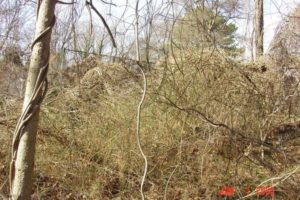
Greenbrier serves as bird cover. Parkside slope below basketball court.
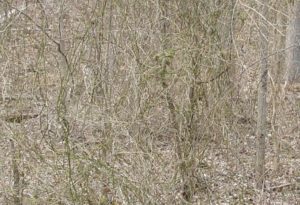
Greenbrier again serving as bird cover, probably section 6 at Parkside
Our low-nesting birds are just as happy raising their young among invasive shrubs and vines as they are among native plants. Their priority is simply a good hiding place, out of view from the many hungry animals that prey on the eggs and young of birds: raccoons, opossums, snakes, foxes, hawks, owls, crows, blue jays, even snapping turtles, all of which occur in Sligo. When invasive vines and shrubs drive out native plants, birds have no choice but to build their nests among the invasives.
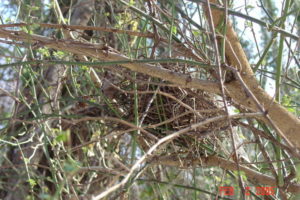
Nest with multiflora rose, porcelainberry, and probably mulberry. Feb. 2, 2005, along Flora Lane
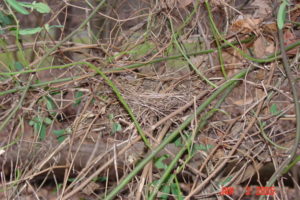
Nest, perhaps in porcelainberry, at Parkside & Rose, Jan 3, 2005
With their sturdy branches, bush honeysuckle and mature multiflora rose (both invasive) offer birds a strong support for the nest. Leaves of surrounding vines such as the Japanese honeysuckle (an invasive) and the common greenbrier (a native) help hide the nest. Multiflora rose is an especially popular nesting site for two of our virtuosic mimics: Mockingbird and gray catbird.
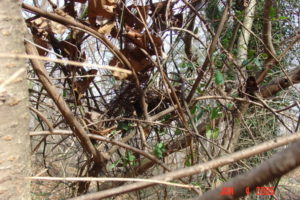
Nest in multiflora rose & japanese honeysuckle, Jan 4, 2005, Parkside slope
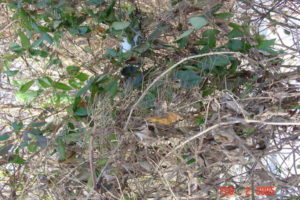
Birdcover of porcelainberry and Japanese Honeysuckle, probably section 6
Removal of invasive shrubs and vines no doubt eliminates a source of nest sites for our low-nesting birds. When invasive vines and shrubs are thoroughly removed from a site, it can leave little understory behind for birds to nest in. The question becomes whether enough native vines such as greenbrier and shrubs like mapleleaf viburnum, arrowwood, and spicebush remain to provide cover for nests. When we are confronted with a large and exclusive cover of multiflora rose (such as the hill between Flora Lane and the Beltway), or of bush-honeysuckle (such as the slope north of Piney Branch), we should consider staggering the removal over several years. This way, bird-nesting habitat will persist while native plants return to cleaned-up areas.
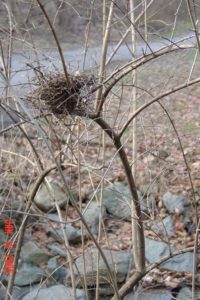
Nest in bush honeysuckle & other, Jan 10, 2005, Flora Lane

Again, Greenbrier serves as bird cover. Parkside slope below basketball court.
A major reason invasive plants are thriving is that deer tend to eat native plants and leave the invasives intact. If Park and Planning takes no steps to reduce the deer population, native shrubs will probably not be able to make a comeback. In this case, it will make sense to leave some invasive shrubs and vines to provide good habitat for our nesting birds.
Photos by Sally Gagne. Text by Sally Gagne and Michael Wilpers.
Sources: C. Robbins, ed., Atlas of the Breeding Birds of Maryland and the District of Columbia (Univ. of Pittsburgh Press, 1996); Hilton Pond Center for Piedmont Natural History, www.hiltonpond.org; C. Dowd, “Effect of Development on Bird Species Composition in Two Urban Forested Wetlands in Staten Island, New York,” J. Field Ornithology, 63/4, 1992; J. Danoff-Burg, Introduced Species Summary Project, Columbia Univ., http://www.columbia.edu/itc/cerc/danoff-burg/invasion_bio/inv_spp_summ/invbio_plan_report_home.html; M. Moran, Study of Northern Virginia Ecology, http://www.fcps.edu/StratfordLandingES/Ecology/home.htm
